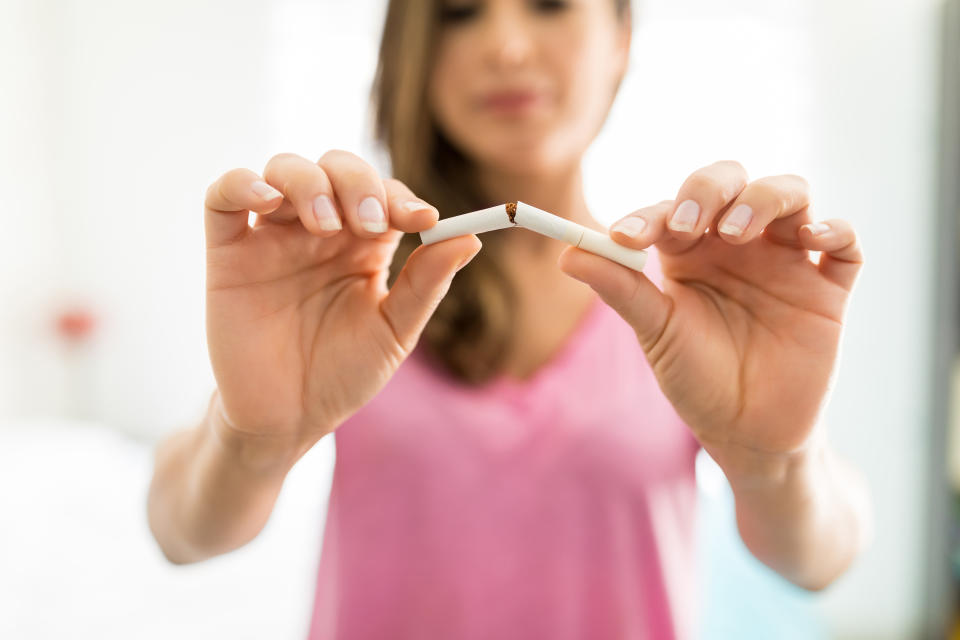Shocking video reveals the 'hidden' cancer-causing chemicals in cigarettes
A shocking video reveals the “hidden” chemicals in cigarettes.
Smoking kills around 78,000 people every year in the UK, according to the NHS.
While most associated with lung cancer, lighting up can also cause tumours in many other parts of the body - including the mouth, bladder, cervix, liver and pancreas.
Cigarettes have also consistently been linked to everything from heart disease and asthma to impotence and infertility.

Smoking is on the decline in the UK, with around 5% fewer adults lighting up in 2018 than 2011, according to the Office for National Statistics.
Nonetheless, 14.7% of adults still smoked two years ago, making up around 7.2m people.
The situation is similar in the US, with 13.7% - 34.2m - adults smoking, data from the Centers for Disease Control and Prevention shows.
More than 16m Americans live with a smoking-related disease, of which there are over 50.
According to a video by Fresh - the UK’s first dedicated regional programme for tobacco control, based in the north east - a mug of tar could be removed from a 20-a-day smoker every year.
The footage shows NHS workers in disbelief, thinking it would take more like a decade for that level of tar to accumulate.
They also learnt the radioactive chemical polonium-210 lurks in cigarettes.
This led one worker to question whether tobacco products should even be available “over the counter”.
Cadmium and acetone, chemicals in batteries and nail varnish remover, are also in cigarettes.
“I think people just see [tobacco] as a plant and [they’re] smoking whatever comes from the plant,” one worker said.
READ MORE: Why your social smoking habit is more unhealthy than you think
Some chemicals in cigarettes do come naturally from the plant, like the addictive nicotine, according to Cancer Research UK.
Others are absorbed from the soil, air or fertilisers.
Chemicals are also added when the tobacco leaves are processed, while others form when the cigarette burns.
Ammonia, a household cleaner, is also in cigarettes.
“You’re cleaning your toilet with it, aren’t you,” one worker said.
“So why would you put it in to your body?”
Ailsa Rutter OBE, director of Fresh, told Yahoo UK: “There is widespread awareness of the harms of smoking but often people don’t realise just how many poisonous chemicals are in cigarette smoke.
“One in two long term smokers will die early, with many people living with smoking-related illnesses.
“There’s lots of help and support out there for people who want to quit.
“Even if you’ve tried to quit before, don’t be put off trying again.
“Your local stop smoking service offers friendly support to improve your chances of stopping. It’s a new decade and a great time to make a quit attempt.”

How to quit smoking
Weaning yourself off cigarettes is not easy, but small lifestyle changes can reduce temptation.
The NHS urges smokers to plan how to go about quitting, including setting a “date”.
“Whenever you find yourself in difficulty, say to yourself, ‘I won't even have a single drag’, and stick with this until the cravings pass,” it recommends.
If you find yourself in a tempting situation, like a party, plan an “escape route in advance” and stick with the non-smokers.
For those who always smoke at certain times - for example after dinner - find distraction, like doing the washing up.
Cravings reportedly last up to five minutes. You could fill this time with going for a quick jog or stroll.
If family or friends want to quit as well, try and combat the cravings together.
READ MORE: US tells smokers to 'stop vaping': what are the health implications of e-cigarettes?
Stop smoking services can help, with research showing smokers are up to four times more likely to quit with expert help and advice.
Find support local to you on the NHS’ location browser.
Nicotine replacement therapy (NRT) - like patches, lozenges or gum - could also double a hopeful-quitter’s chance of success.
NRT provides smokers with a low level of nicotine, without all the other chemicals.
It may help reduce cravings and withdrawal symptoms, like irritability.
Some also turn to e-cigarettes, which deliver nicotine in a vapour, avoiding “most of the harmful effects of smoking”.
Research suggests vaping may carry its own risks, but is still universally considered far better than smoking.
The NHS has more information on stop smoking treatments.
Try and also keep your hands and mouth “busy” by holding, or drinking through, a straw.
Throughout it all, stay positive and remind yourself why you are quitting.
Ex-smoker Chris, 28, told the NHS: “I used to take a picture of my baby daughter with me when I went out.
“If I was tempted, I'd look at that.”

 Yahoo Lifestyle
Yahoo Lifestyle 
